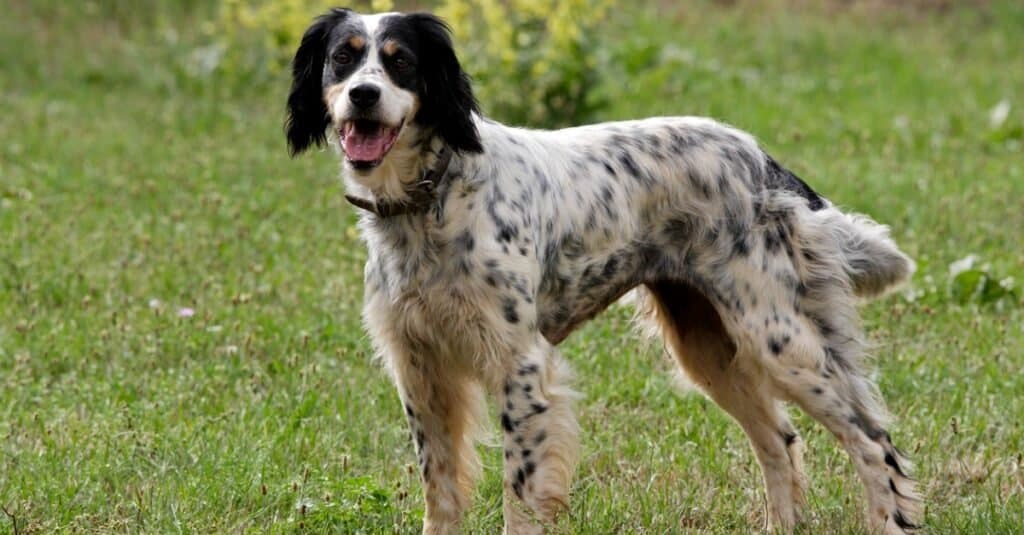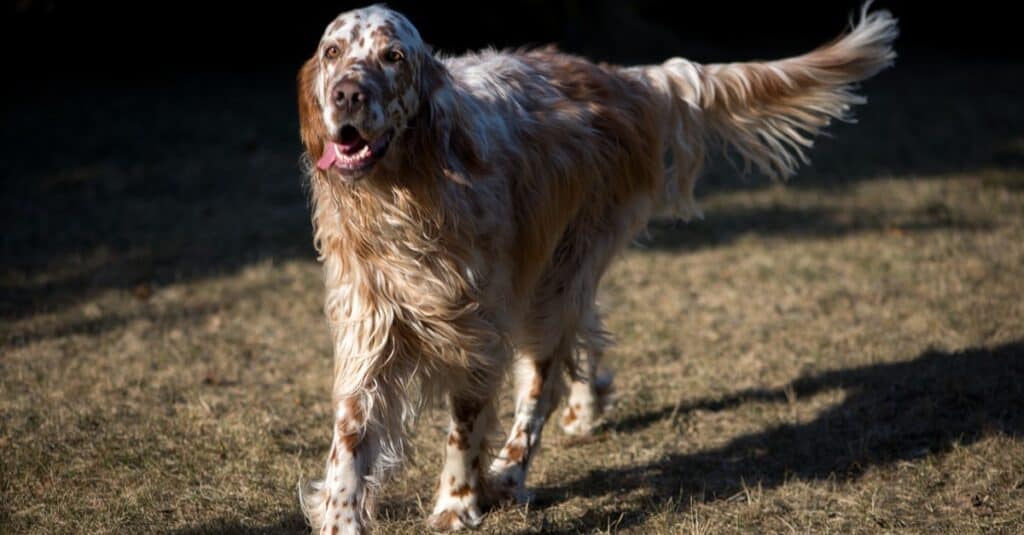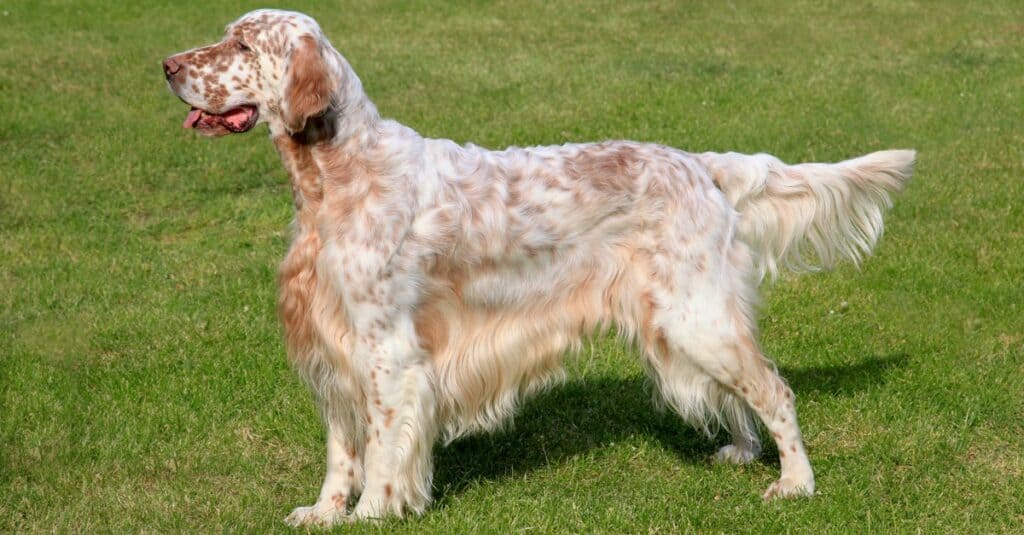English Setter
Canis lupus
English Setters were first bred between 400 and 500 years ago.
Advertisement
English Setter Scientific Classification
- Kingdom
- Animalia
- Phylum
- Chordata
- Class
- Mammalia
- Order
- Carnivora
- Family
- Canidae
- Genus
- Canis
- Scientific Name
- Canis lupus
Read our Complete Guide to Classification of Animals.
English Setter Conservation Status
English Setter Facts
- Fun Fact
- English Setters were first bred between 400 and 500 years ago.
- Temperament
- Friendly, affectionate, and gentle
- Diet
- Omnivore
English Setter as a Pet:
- General Health
- Energy Level
- Shedability
- Trainability
- Intelligence
- Tendency to Chew
- Size
- Family and kid friendliness
- Yappiness / Barking
- Moderate
- Separation Anxiety
- High
- Preferred Temperature
- Average climate
- Exercise Needs
- High
- Friendly With Other Dogs
- High
- Pure bred cost to own
- $1,000 to $1,500
- Dog group
- Sporting
- Male weight
- 65-80 lbs
- Female weight
- 45-55 lbs
This post may contain affiliate links to our partners like Chewy, Amazon, and others. Purchasing through these helps us further the A-Z Animals mission to educate about the world's species.
View all of the English Setter images!
The English Setter was likely first bred between 400 and 500 years ago. It is believed that they were bred by mixing Spanish Pointers, Water Spaniels, and Springer Spaniels.
The English Setter was given its name because they were bred to “set” or quietly lay down when looking for birds to hunt. Their human hunting companion would cast a large net to cover the birds in their area and try to catch them. With the development of firearms and advancements in hunting, the setter breeds began to be further developed to stand in the style Pointer dogs are known for.
See all of our expert product reviews.
English Setters have a gorgeous long and silky coat. Their coat may be a variety of colors including blue belton, liver belton, lemon belton, blue belton, and tan, or tricolor. They will need weekly brushing to keep shedding down and prevent their long hair from getting matted or tangled. The average lifespan of an English Setter is between 11 and 15 years.
English Setters continue to make good hunting companions, but they can also make a wonderful addition to a family. They are very loving, affectionate, and playful. This breed is also quite active and will need a home where they will receive sufficient exercise.

Owning an English Setter: 3 Pros and Cons
| Pros! | Cons! |
|---|---|
| Friendly: English Setters are very friendly and affectionate. | High exercise needs: English Setters are an active breed and will require daily exercise. |
| Good with kids: English Setters are quite tolerant of young children and can make a good addition to a family. | May become nuisance barkers: Without proper training, this breed may bark a good amount. |
| Healthy: English Setters are an overall healthy dog breed. | Training can be challenging: English Setters are not as easy to train as some other breeds. |
Size and Weight

©janveber/Shutterstock.com
English Setters are a medium to large dog breed. Males typically weigh between 65 and 80 pounds and are between 25 and 27 inches tall. Females are a bit smaller, generally weighing 45 to 55 pounds and standing between 23 and 25 inches tall. While puppies typically only weigh between 16 and 25 pounds at three months of age, by the time they are six months old, their weight will increase to between 29 and 46 pounds. Both males and females are full-grown by the time they are 16 months.
| Height (Male) | 25 inches to 27 inches |
| Height (Female) | 23 inches to 25 inches |
| Weight (Male) | 65 pounds to 80 pounds |
| Weight (Female) | 45 pounds to 55 pounds |
Origins

The ancestors of English setters were hunters’ constant companions for centuries
Health and Entertainment for your English Setter
See all of our expert product reviews.
©WiP-Studio/Shutterstock.com
The English Setter in its present incarnation belongs to the relentless efforts of two 19th-century breeders.
The first of them was Edward Laverack who created his very own variety of the breed through a careful selection process. The second of them was Richard Purcell Llewellin who bred the best canines from Laverack’s kennels with bloodlines from his own.
However, before then, the ancestors of these dogs aided their masters in hunting birds over four centuries ago in England. Their duties involved sniffing out their quarry and remaining still informing the hunter of the presence of birds in the vicinity, before advancing stealthily at a given signal and startling the birds into flight.
Through the evolution of bird hunting, they remained a constant companion regardless of whether hawks, nets, or guns were used.
Their names come from the distinct still crouch, they adopt in the presence of prey.
Common Health Issues

English Setters may suffer from elbow or hip dysplasia
©janveber/Shutterstock.com
All-in-all, the English Setter is a healthy breed. Still, there are a few common health concerns to be aware of before adopting this breed.
Hip dysplasia is one of these concerns. This is a genetic condition where the dog’s hip joint isn’t formed correctly. This causes the bones to rub against one another, which can make it very uncomfortable to walk and may require surgery. Always work with responsible breeders who are upfront and transparent about the puppy’s parents.
English Setters may also develop elbow dysplasia. Like hip dysplasia, this is another inheritable condition, making it that much more important to look for reputable breeders. With elbow dysplasia, the bones that make up the dog’s elbow are believed to grow at different rates. This can interfere with the joint functioning properly and can cause lameness or arthritis. Monitoring and controlling a dog’s weight can help lessen some of the problems elbow dysplasia may cause.
A third potential concern for English Setters is hypothyroidism. This is a condition where the thyroid levels are too low. It can lead to a variety of problems including infertility, lethargy, obesity, mental problems, and irregular heat cycles. Dogs with this condition will require daily thyroid medication, which can keep them healthy.
As a summary, below are some potential health concerns English Setters may face:
- Hip dysplasia
- Elbow dysplasia
- Hypothyroidism
Temperament and Behavior

English Setters are especially active. playful, and energetic
©iStock.com/Michel VIARD
English Setters have a very friendly and affectionate personality. They are very gentle and kind with those they meet. They also are very tolerant of young children. These traits mean that this breed can make a wonderful family dog.
They were bred for hunting and enjoy being very active each day. English Setters can be quite playful due to their energy, but they’ll also need sufficient exercise each day. If their exercise is not met, they may become overly active inside and begin exhibiting undesirable behaviors.
How to Take Care of an English Setter

English Setters should be fed high-quality food rich in chondroitin, glucosamine, and DHA to prevent joint issues such as hip dysplasia
©Zelma Brezinska/Shutterstock.com
When taking care of an English Setter, it is important to consider the breed’s temperament, nutrition needs, training and exercise needs, and other characteristics. This will help ensure you provide your dog with the care they need to be happy and healthy.
The Best Dog Food for English Setters
Most adult English Setters should eat between 2 and 3 cups of food each day. Always choose a high-quality dog food that will help your English Setter get the nutrients he or she needs. The exact amount of food your dog will require can vary based on his or her age, weight, activity level, and other factors. If you are unsure how much to feed your dog, consult with their veterinarian for guidance.
English Setter puppies should be fed high-quality puppy food. Additionally, it is important to understand that since the puppies have a smaller stomach, they will need to be fed smaller meals more frequently throughout the day. Most puppies should be fed between three and four meals until they are around one year old. Again, your dog’s veterinarian is a good resource if you are unsure how much or how frequently they should eat.
Since this breed’s foremost health problem is joint dysplasia, look for dog food containing glucosamine and chondroitin sulfate.
At A-Z Animals, we say the best dog food for English Setters is Eukanuba Adult Large Breed Dry Dog Food.
The concentration of chondroitin, glucosamine and DHA in this food helps mitigate joint problems like hip and elbow dysplasia. The DHA, combined with vitamin E, also supports brain function. Since it’s protein-packed with quality meats, this dog food supports the highly active lifestyle needed to maintain a reasonable weight for joint protection.
Get Eukanuba Large Breed Dog Food on Chewy or Amazon.
- Adult large breed dry dog food for large breed dogs 15 months or older, weighing over 55 lb.
- Promotes lean muscle development and joint health in active adult dogs with a combination of animal protein, chondroitin sulfate, and glucosamine.
- Helps keep dogs sharp and supports healthy brain function with DHA and vitamin E.
- Fuels an active lifestyle with optimal levels of fats and carbohydrates.
Maintenance and Grooming

English setters require weekly brushing and regular brushing of their teeth, and cleaning of their ears
©Gonzalo Jara/Shutterstock.com
English Setters have a gorgeous long coat that may be a variety of colors including blue belton, lemon belton, liver belton, blue belton, and tan, or tricolor. Due to the length of their coat, it is important to brush this breed at least once a week using a soft bristle brush. You may also need a long-toothed metal comb to help remove tangles. If the English Setter’s coat isn’t properly groomed, it can become matted, making it uncomfortable for the dog or even leading to potential skin problems. Regular brushing will also help keep shedding to a minimum.
In addition to regular brushing, an English Setter will also need the hair around their face and feet to be trimmed to keep it from getting too long. Their teeth should also be brushed on a regular basis, their ears should be kept clean, and their nails should be trimmed to keep them from getting too long and causing the dog discomfort when he walks.
Training

English Setters have a mind of their own and must be trained and socialized as early as possible
©Radomir Rezny/Shutterstock.com
Overall, English Setters aren’t too difficult to train, but they are not among the easiest breeds either. They are known to be strong-willed at times and will need a firm leader to set clear boundaries. However, this breed does not respond well to harsher training techniques, so rather uses more positive training methods.
In addition to training your dog from an early age, be sure to socialize him or her as well. Bring your English Setter with you to different environments and allow him or her to be around different people. This will help ensure that they are clear on expectations and how to interact.
Exercise
English Setters were bred for hunting and have a high energy level. This breed requires regular exercise every day. Take your dog on daily walks, or even runs, and give them plenty of time to run around and play in a fenced-in yard or dog park.
Puppies

English Setter Puppies must be welcomed to puppy-proofed homes which have been fully prepared for their arrival
©Minko Peev/Shutterstock.com
Before bringing home an English Setter puppy, make sure you have a puppy-proof space in your home. Remove anything that could be a potential hazard to the dog or personal items that you wouldn’t want to see destroyed by a young puppy. Additionally, make sure you purchase a crate, dog bed, food, and all the other supplies your new puppy will need before bringing him or her home so you’re fully prepared when they arrive.
While English Setters have a high exercise need, it is important to be careful not to overexercise puppies or have them engage in high impact activities. Until they are around two years old, their bones and joints haven’t reached mature strength and could easily be injured.
English Setters and Children
English Setters do very well with children. They are friendly, calm, and tolerant of children. This breed also enjoys playing and could make a great playmate for a young child.
However, as with any other dog breed, it is important to always supervise children when they are around an English Setter. This can help prevent either the child or dog from getting accidentally injured.
Dogs similar to English Setter
Irish Setters, English Pointers, and Brittany Dogs are three breeds that are similar to the English Setter.
- Irish Setter: Irish Setters and English Setters are both hunting dogs. Both breeds are similarly sized with males weighing an average of about 70 pounds. While Irish Setters are typically mahogany or red in color, English Setters can be a variety of colors including blue, belton, lemon, tan, liver, or tricolor.
- English Pointer: English Pointers and English Setters are both very affectionate and friendly dogs that do very well with children and other dogs. Both breeds also have a very high energy level and require a good amount of exercise. English Pointers are easier to groom and are known for shedding less than English Setters.
- Brittany Dog: Brittany Dogs are another hunting dog. However, while English Setters were originally bred in England, Brittany Dogs were originally bred in France. Both breeds do well with children and other pets, but the English Setter is more tolerant of strangers. Brittany Dogs are smaller than English Setters. The average weight of a male Brittany dog is 37.5 pounds compared to the 67.5-pound average weight of a male English Setter.
Famous English Setters
Over the years, many famous individuals have chosen to own an English Setter as a pet. These include:
- Clark Gable
- Annie Oakley,
- Brigitte Bardot
- Glenn Gould
Popular Names for English Setter
If you are undecided about which name to give your new English Setter, consider some of these popular choices:
- Bradley
- Chase
- Ethan
- Hunter
- Drake
- Gracie
- Faye
- Kelsey
- Sage
- Mable
English Setter FAQs (Frequently Asked Questions)
How much does an English Setter cost to own?
The cost to purchase an English Setter from a breeder is typically between $1,000 and $1,500. When deciding between different breeders in your area, be sure to do your research and choose a breeder with a good reputation. It may also be possible to find an English Setter up for adoption through a local rescue. The cost to adopt through a rescue should be significantly less than a breeder will charge, and will likely be a few hundred dollars.
As your budgeting to take care of your English Setter, keep in mind that the average lifespan for this breed is 11 to 15 years. You’ll need to be prepared to offer them the care they need for this entire lifespan. Budget at least $1,000 to $1,500 for the first year owning the dog and $500 to $1,000 for each subsequent year to cover all the expenses associate with pet ownership.
How long does an English Setter live?
The average lifespan of an English Setter is 11 to 15 years.
Are English Setters good family dogs?
Yes, English Setters are good family dogs. They are gentle, kind, and patient with children. English Setters also have a higher energy level and can make a good playmate for a child.
Are English Setters aggressive?
No, English Setters are not a very aggressive breed. If provoked or threatened, it is possible for them to exhibit aggressive behaviors, but they should also calm down quickly when asked by their owners.
How much is an English Setter puppy?
English Setter puppies typically cost between $1,000 and $1,500 to purchase from a breeder. Rescues may also offer English Setter puppies. In this case, the cost to adopt will likely be a few hundred dollars.
Are English Setters Hard to train?
English Setters can be a bit more challenging to train that some other breeds. They can be strong-willed at time. However, with a strong leader who uses positive training methods, this breed can be quite trainable.
What does an English Setter look like?
English Setters are known for their elegant looks. They have a long silky coat that can be liver belton, lemon belton, blue belton, blue belton and tan, or tricolor. English Setters are a medium to large breed. The males are a bit larger than the females, weighing between 65 and 80 pounds and standing between 25 and 27 inches tall (compared to a female’s weight of 45 to 55 pounds and height of 23 to 25 inches).
What's the difference between English Setters and Llewellin Setters?
All Llewellin Setters are English Setters, but not all English Setters are Llewellin Setters. In fact, Llewellin Setters are their own distinct bloodline of English Setter, though there are very few differences between the two breeds.
Thank you for reading! Have some feedback for us? Contact the AZ Animals editorial team.
Sources
- American Kennel Club, Available here: https://www.akc.org/dog-breeds/english-setter/
- Dog Time, Available here: https://dogtime.com/dog-breeds/english-setter#/slide/1
- Wikipedia, Available here: https://en.wikipedia.org/wiki/English_Setter
- Pet Finder, Available here: https://www.petfinder.com/dog-breeds/english-setter/
- Dog Breeds List, Available here: https://www.dogbreedslist.info/all-dog-breeds/english-setter.html


















